Contents
| |||||
| Decades: | |||||
|---|---|---|---|---|---|
| See also: | |||||
Events in the year 1810 in Mexico.
| |||||
| Decades: | |||||
|---|---|---|---|---|---|
| See also: | |||||
Events in the year 1810 in Mexico.
| | This section needs expansion. You can help by adding to it. (April 2011) |
| | This section needs expansion. You can help by adding to it. (October 2010) |

Don Miguel Gregorio Antonio Ignacio Hidalgo y Costilla Gallaga Mandarte y Villaseñor, commonly known as Miguel Hidalgo y Costilla or Miguel Hidalgo, was a Catholic priest, leader of the Mexican War of Independence and recognized as the Father of the Nation.
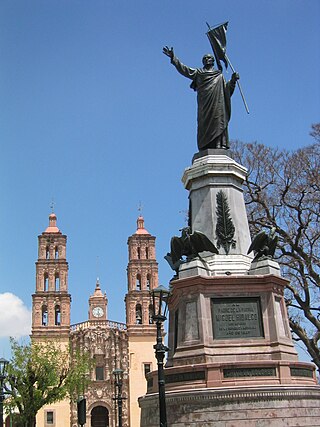
The Cry of Dolores occurred in Dolores, Mexico, on 16 September 1810, when Roman Catholic priest Miguel Hidalgo y Costilla rang his church bell and gave the call to arms that triggered the Mexican War of Independence. The Cry of Dolores is most commonly known by the locals as "El Grito de Independencia".
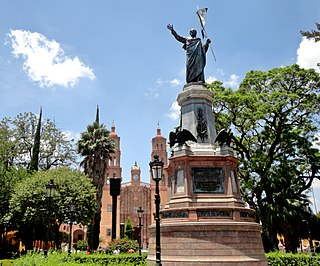
Dolores Hidalgo is the name of a city and the surrounding municipality in the north-central part of the Mexican state of Guanajuato.
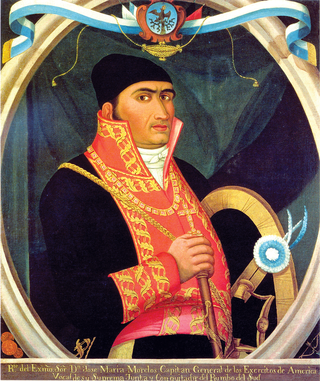
José María Teclo Morelos Pérez y Pavón was a Mexican Catholic priest, statesman and military leader who led the Mexican War of Independence movement, assuming its leadership after the execution of Miguel Hidalgo y Costilla in 1811.

The Mexican War of Independence was an armed conflict and political process resulting in Mexico's independence from the Spanish Empire. It was not a single, coherent event, but local and regional struggles that occurred within the same period, and can be considered a revolutionary civil war. It culminated with the drafting of the Declaration of Independence of the Mexican Empire in Mexico City on September 28, 1821, following the collapse of royal government and the military triumph of forces for independence.
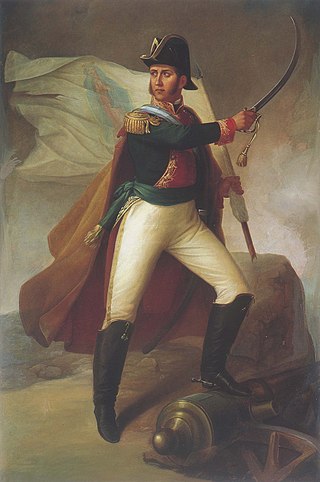
Ignacio José de Allende y Unzaga, commonly known as Ignacio Allende, was a captain of the Spanish Army in New Spain who came to sympathize with the Mexican independence movement. He attended the secret meetings organized by Josefa Ortiz de Domínguez, where the possibility of an independent Mexico was discussed. He fought along with Miguel Hidalgo y Costilla in the first stage of the struggle, eventually succeeding him in leadership of the rebellion. Allende was captured by Spanish colonial authorities while he was in Coahuila and executed for treason in Chihuahua.

Juan Aldama was a Mexican revolutionary rebel soldier during the Mexican War of Independence in 1810.

Francisco Javier Venegas de Saavedra y Ramínez de Arenzana, 1st Marquess of Reunión and New Spain, KOC was a Spanish general in the Spanish War of Independence and later viceroy of New Spain from September 14, 1810, to March 4, 1813, during the first phase of the Mexican War of Independence.

Félix María Calleja del Rey y de la Gándara, primer conde de Calderón was a Spanish military officer and viceroy of New Spain from March 4, 1813, to September 20, 1816, during Mexico's War of Independence. For his service in New Spain, Calleja was awarded with the title Count of Calderon.
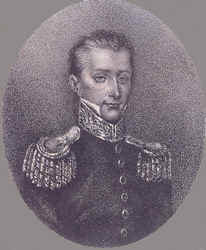
José Mariano Michelena was a New Spain and later Mexican, soldier and politician. He was among the early conspirators seeking to achieve Mexican independence, and also introduced coffee to Mexico.

José Miguel Domínguez Alemán was a New Spanish colonial official in New Spain who played a part in the Mexican independence movement. He was also a member of a transitional governing committee in the period between the abdication of Mexican Emperor Agustín de Iturbide and the installation of Guadalupe Victoria as the first president of independent Mexico. His wife, Josefa Ortiz de Domínguez, also known as La Corregidora, was a heroine of Mexican independence.

Jose Mariano de Abasolo (1783–1816) was a Mexican revolutionist, born at Dolores, Guanajuato. He participated in the revolution started by Miguel Hidalgo.

Pénjamo is the seat of Pénjamo municipality, one of 46 municipalities of Guanajuato, Mexico. It was cofounded in 1549 by Guamares, Purépechas, and Otomis prior to the outbreak of the Chichimeca war.
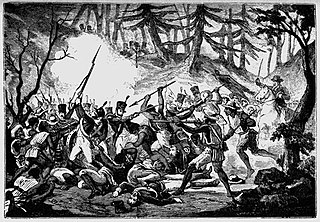
The Battle of Monte de las Cruces was one of the pivotal battles of the early Mexican War of Independence, in October 1810.
This is a timeline of events related to the Spanish American wars of independence. Numerous wars against Spanish rule in Spanish America took place during the early 19th century, from 1808 until 1829, directly related to the Napoleonic French invasion of Spain. The conflict started with short-lived governing juntas established in Chuquisaca and Quito opposing the composition of the Supreme Central Junta of Seville. When the Central Junta fell to the French, numerous new Juntas appeared all across the Americas, eventually resulting in a chain of newly independent countries stretching from Argentina and Chile in the south, to Mexico in the north. After the death of the king Ferdinand VII, in 1833, only Cuba and Puerto Rico remained under Spanish rule, until the Spanish–American War in 1898.

The Battle of Zitácuaro took place during the War of Mexican Independence on 2 January 1812 in the area around Zitácuaro, Michoacán. The battle was fought between the royalist forces loyal to the Spanish crown and the Mexican rebels fighting for independence from the Spanish Empire. The Mexican insurgents were commanded by General Ignacio López Rayón and the Spanish by Félix María Calleja. The battle resulted in a victory for the Spanish Royalists even in the face of overwhelming odds.

The siege of Cuautla was a battle of the War of Mexican Independence that occurred from 19 February through 2 May 1812 at Cuautla, Morelos. The Spanish royalist forces loyal to the Spanish, commanded by Félix María Calleja, besieged the town of Cuautla and its Mexican rebel defenders fighting for independence from the Spanish Empire. The rebels were commanded by José María Morelos y Pavón, Hermenegildo Galeana, and Mariano Matamoros. The battle results are disputed, but it is generally agreed that the battle resulted more favorably for the Spanish whose siege was ultimately successful with the Mexican withdrawal on 2 May 1812.

The following is a partial timeline (1810–1812) of the Mexican War of Independence (1810–1821), its antecedents and its aftermath. The war pitted the royalists, supporting the continued adherence of Mexico to Spain, versus the insurgents advocating Mexican independence from Spain. After of struggle of more than 10 years the insurgents prevailed.

The Capture of Alhóndiga de Granaditas was a military action carried out in Guanajuato, viceroyalty of New Spain, on September 28, 1810, between the royalist soldiers of the province and the insurgents commanded by Miguel Hidalgo and Ignacio Allende. The fear unleashed in the social circles of the provincial capital made the intendant, Juan Antonio Riaño, ask the population to barrack in the Alhóndiga de Granaditas, a granary built in 1800, and in whose construction Miguel Hidalgo had participated as an advisor to his old friend Riaño. After several hours of combat, Riaño was killed and the Spaniards who had taken refuge there wished to surrender. The military in the viceroy's service continued the fight, until the insurgents managed to enter and then massacred not only the few guards that defended it, but also the numerous families of civilians who had taken refuge there. Many historians consider this confrontation more like a mutiny or massacre of civilians than a battle, since there were no conditions of military equality between the two sides.